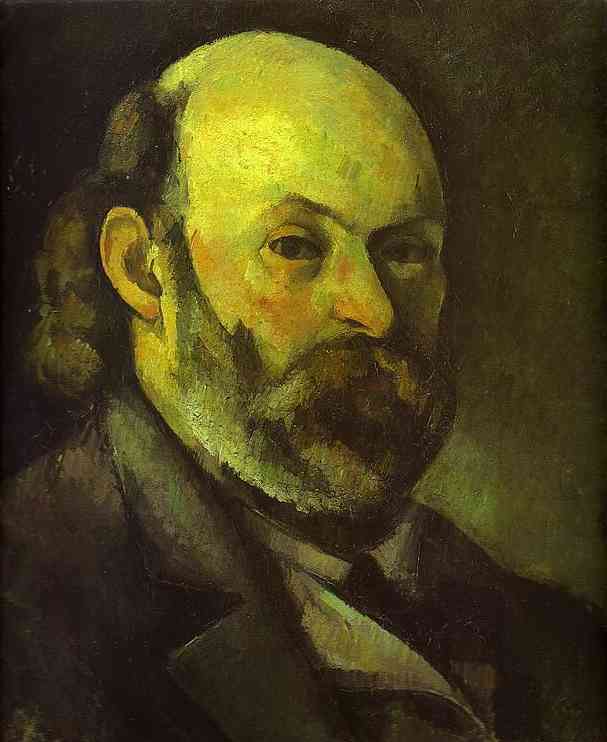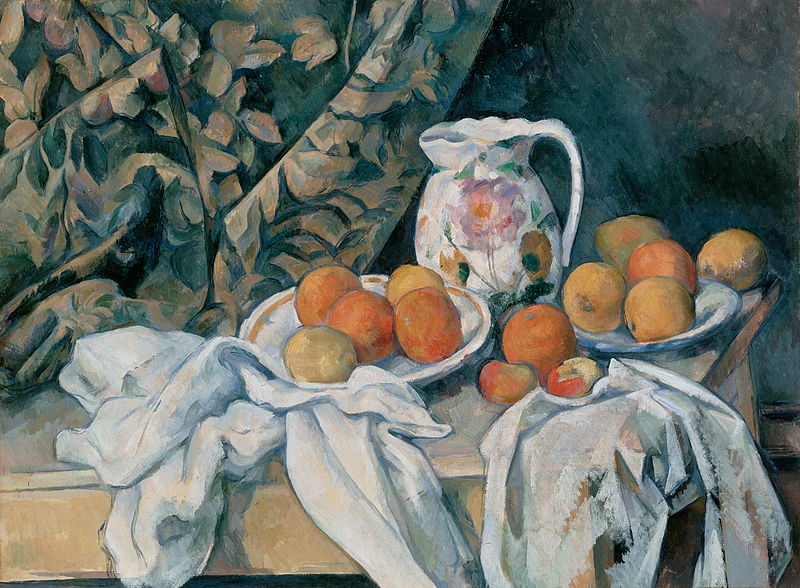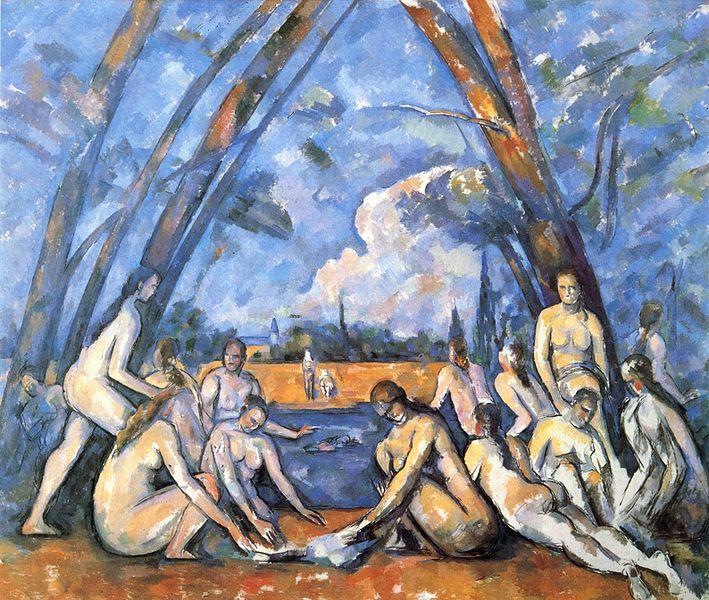Paul Cézanne (1839–1906) was a French artist and Post-Impressionist painter whose work laid the foundations of the transition from the 19th century conception of artistic endeavour to a new and radically different world of art in the 20th century. Paul Cézanne can be said to form the bridge between late 19th century Impressionism and the early 20th century's new line of artistic enquiry, Cubism. The line attributed to both Matisse and Picasso that Cézanne "is the father of us all" cannot be easily dismissed.
Paul Cézanne's often repetitive, exploratory brushstrokes are highly characteristic and clearly recognizable. He used planes of colour and small brushstrokes that build up to form complex fields. The paintings convey Cézanne's intense study of his subjects. (Paul Cézanne Biography)
Early years and family of Paul Cezanne:
The Cézannes came from the small town of Cesana now in West Piedmont, and it has been assumed that the surname came from Italian origin. Paul Cézanne was born on 19th January 1839 in Aix-en-Provence, in Provence in the South of France. On 22 February, Paul was baptized in the parish church, with his grandmother and uncle Louis as godparents. His father, Louis-Auguste Cézanne (28 July 1798 – 23 Oct. 1886), was the co-founder of a banking firm that prospered throughout the artist's life, affording him financial security that was unavailable to most of his contemporaries and eventually resulting in a large inheritance.
Femme au Chapeau Vert (Woman in a Green Hat. Madame Cézanne.) 1894–1895
On the other hand, his mother, Anne Elisabeth Honorine Aubert (24 September 1814 – 25 Oct.1897), was "vivacious and romantic, but quick to take offence". It was from her that Paul got his conception and vision of life. He also had two younger sisters, Marie and Rose, with whom he went to a primary school every day.
At the age of ten Paul entered the Saint Joseph school, where he studied drawing under Joseph Gibert, a Spanish monk, in Aix. In 1852 Cézanne entered the Collège Bourbon (now Collège Mignet), where he met and became friends with Émile Zola, who was in a less advanced class, as well as Baptistin Baille—three friends who would come to be known as "les trois inséparables" (the three inseparables). He stayed there for six years, though in the last two years he was a day scholar.[10] From 1858 to 1861, complying with his father's wishes, Cézanne attended the law school of the University of Aix, while also receiving drawing lessons.
Going against the objections of his banker father, he committed himself to pursuing his artistic development and left Aix for Paris in 1861. He was strongly encouraged to make this decision by Zola, who was already living in the capital at the time. Eventually, his father reconciled with Cézanne and supported his choice of career. Cézanne later received an inheritance of 400,000 francs (£218,363.62) from his father, which rid him of all financial worries.
In Paris, Cézanne met the Impressionist Camille Pissarro. Initially the friendship formed in the mid-1860s between Pissarro and Cézanne was that of master and disciple, in which Pissarro exerted a formative influence on the younger artist. Over the course of the following decade their landscape painting excursions together, in Louveciennes and Pontoise, led to a collaborative working relationship between equals.
Paul Cézanne's early work is often concerned with the figure in the landscape and includes many paintings of groups of large, heavy figures in the landscape, imaginatively painted. Later in his career, he became more interested in working from direct observation and gradually developed a light, airy painting style. Nevertheless, in Paul Cézanne's mature work there is the development of a solidified, almost architectural style of painting. Throughout his life he struggled to develop an authentic observation of the seen world by the most accurate method of representing it in paint that he could find. To this end, he structurally ordered whatever he perceived into simple forms and colour planes. His statement "I want to make of impressionism something solid and lasting like the art in the museums", and his contention that he was recreating Poussin "after nature" underscored his desire to unite observation of nature with the permanence of classical composition.
Paul Cézanne was interested in the simplification of naturally occurring forms to their geometric essentials; he wanted to "treat nature by the cylinder, the sphere, the cone" (a tree trunk may be conceived of as a cylinder, an apple or orange a sphere, for example). Additionally, Cézanne's desire to capture the truth of perception led him to explore binocular vision graphically, rendering slightly different, yet simultaneous visual perceptions of the same phenomena to provide the viewer with a different aesthetic experience of depth than those of earlier ideals of perspective, in particular single-point perspective.
Exhibitions and subjects:
Paul Cézanne's paintings were shown in the first exhibition of the Salon des Refusés in 1863, which displayed works not accepted by the jury of the official Paris Salon. The Salon rejected Cézanne's submissions every year from 1864 to 1869. He continued to submit works to the Salon until 1882. In that year, through the intervention of fellow artist Antoine Guillemet, he exhibited Portrait of Louis-Auguste Cézanne, Father of the Artist, reading 'l'Evénement', 1866 (National Gallery of Art, Washington, D.C.), his first and last successful submission to the Salon.
Still Life with a Curtain (1895) illustrates Cézanne's increasing trend towards terse compression of forms and dynamic tension between geometric figures.
Before 1895 Paul Cézanne exhibited twice with the Impressionists (at the first Impressionist exhibition in 1874 and the third Impressionist exhibition in 1877). In later years a few individual paintings were shown at various venues, until 1895, when the Parisian dealer, Ambroise Vollard, gave the artist his first solo exhibition. Despite the increasing public recognition and financial success, Cézanne chose to work in increasing artistic isolation, usually painting in the south of France, in his beloved Provence, far from Paris.
He concentrated on a few subjects and was equally proficient in each of these genres: still lifes, portraits, landscapes and studies of bathers. For the last, Cézanne was compelled to design from his imagination, due to a lack of available nude models. Like the landscapes, his portraits were drawn from that which was familiar, so that not only his wife and son but local peasants, children and his art dealer served as subjects. His still lifes are at once decorative in design, painted with thick, flat surfaces, yet with a weight reminiscent of Gustave Courbet. The 'props' for his works are still to be found, as he left them, in his studio (atelier), in the suburbs of modern Aix.
Although religious images appeared less frequently in Paul Cézanne's later work, he remained a devout Roman Catholic and said, "When I judge art, I take my painting and put it next to a God-made object like a tree or flower. If it clashes, it is not art."
Paul Cézanne's paintings were not well received among the petty bourgeoisie of Aix. In 1903 Henri Rochefort visited the auction of paintings that had been in Zola's possession and published on 9 March 1903 in L'Intransigeant a highly critical article entitled “Love for the Ugly”.
Rochefort describes how spectators had supposedly experienced laughing fits, when seeing the paintings of “an ultra-impressionist named Paul Cézanne”. Erroneously believing that Paul Cézanne's paintings in fact represented “the art dear to Zola” (Rochefort's Dreyfusard arch-enemy), he drew connections between “Dreyfusard snobs”, the French officer who was accused but innocent of having sold defense plans to the fatherland and Zola's supposedly cherished artist, Cézanne. The public in Aix was overwhelmed with happiness, and for many days, copies of L'Intransigeant appeared on Paul Cézanne's door-mat with messages asking him to leave the town “he was dishonouring”.
The above article refer to: http://en.wikipedia.org/wiki/Paul_C%C3%A9zanne
Edited by Kevin from Xiamen Romandy Art Limited.
(Xiamen Romandy Art is a professional oil paintings supplier from China. If you want to convert your photos into high quality oil paintings, or you want the masterpiece oil painting reproductions, please don's hesitate to contact with us.)
Romandy Art Website: http://www.oilpaintingcentre.com
Tags: Paul Cézanne Biography, Cezanne the artist, Paul Cézanne Oil Painting Painter. |